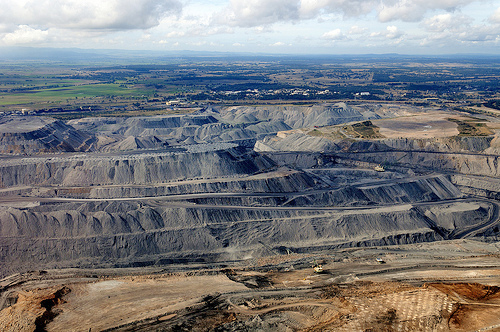Somehow we have to find a way of connecting political and business talk about fossil fuels with the physical consequences of burning them [13 January 2015 | Peter Boyer]
A paper published in the renowned science journal Nature last week delivered the sobering news that for a reasonable chance of keeping global warming within safe limits, almost all of Australia’s known coal reserves must stay where they are.
The Prime Minister, on the other hand, can think of “few things more damaging to our future” than leaving Australian coal in the ground. Exporting coal – “affordable energy” – was Australia’s gift to the world, Tony Abbott told mining industry leaders at a gala dinner last year.
Both can’t be right. If you believe Australian coal is a gift to the world you clearly reject the proposition that burning it endangers our future. It’s either science or the prime minister.
The Nature paper, by specialist scientists and economists from the University College London (UCL), builds on previous analyses by the International Energy Agency and the Intergovernmental Panel on Climate Change.
Given that average global temperature rises are closely related to cumulative fossil fuel emissions over a given timeframe, both these organisations say that it would be unsafe to burn more than a third of the world’s coal, oil and gas reserves before 2050.
The UCL study factored in other data, including cost of extraction and distance from mine to market, to determine the extent to which particular national and regional reserves could continue to be exploited to stay within safe emission limits.
Australian coal reserves look anything but a long-term prospect. That applies with or without carbon capture and storage (CCS), a costly, unproven technology still sitting in the wings after 20 years of business and political promises that it will turn coal into a clean, green resource.
The UCL study finds that without CCS, to keep warming within safe limits we would need to leave 95 per cent of Australian coal where it is (along with 46 per cent of our oil and 51 per cent of our natural gas) in the period to 2050.
Effectively deploying CCS would still require Australia to leave 93 per cent of its coal in the ground over those 35 years, a princely gain of just 2 per cent after all those years of promises. I’m willing to bet that the CCS silver bullet will never be fired.
This and other evidence from multiple sources is telling us that to stay below the 2C target that governments committed to at Cancún in 2010, the only safe, cost-effective policy is to stop looking for more fossil fuel reserves and prepare to close most existing coal mines.
But as the Nature paper says, national leaders and policy makers have a natural instinct “to exploit rapidly and completely their territorial fossil fuels”. The result is generous public funding to support exploration for coal, oil and gas reserves, which fossil fuel interests carefully avoid mentioning when complaining about renewable subsidies.
Coal, oil and gas companies and their investors expect that known accessible reserves, and many that are currently inaccessible, will be exploited, and that governments will back them every step of the way. As they do, which puts a new light on those pledges to limit emissions.
It’s not just an Australian problem. If you take out those countries completely lacking fossil fuel reserves and one or two European administrations with established renewable policies, no government is prepared to rule out exploiting its fossil energy potential to the full.
The fossil-fuel bubble will inevitably burst. If this takes many years, the environmental devastation will continue, the climate crisis will get steadily worse, and that promise of a fossil fuelled heaven will be seen as something else entirely, a fossil-fuelled apocalypse.
In NSW and Queensland, the frontline symbols of the government-industry alliance are the police who deal with people protesting against the disruption to their lives caused by mineral activity.
In Tasmania, where mining of coal and gas is not currently in the spotlight, the alliance is manifested in the Hodgman government’s legislated moves against public protest and its plan to allow corporations to sue individuals for defamation.
Simon Bevilacqua’s perceptive “Road Runner” article (Mercury, January 1) describes the government tactic of looking for ways of dividing communities rather than seeking to engage with them. As he says, it misreads the public mood and is ultimately futile.
The protest scene everywhere is changing. Poorly-regulated exploitation of public resources, including landscapes, is breeding community resentment and bringing new people to the barricades. That mood will fester and grow for as long as governments favour private over public interest.
The tide is turning. Investors are starting to abandon fossil fuel. If industry players are to get out of the hole that (with government help) they’ve dug for themselves, they’ll have to stop digging.

